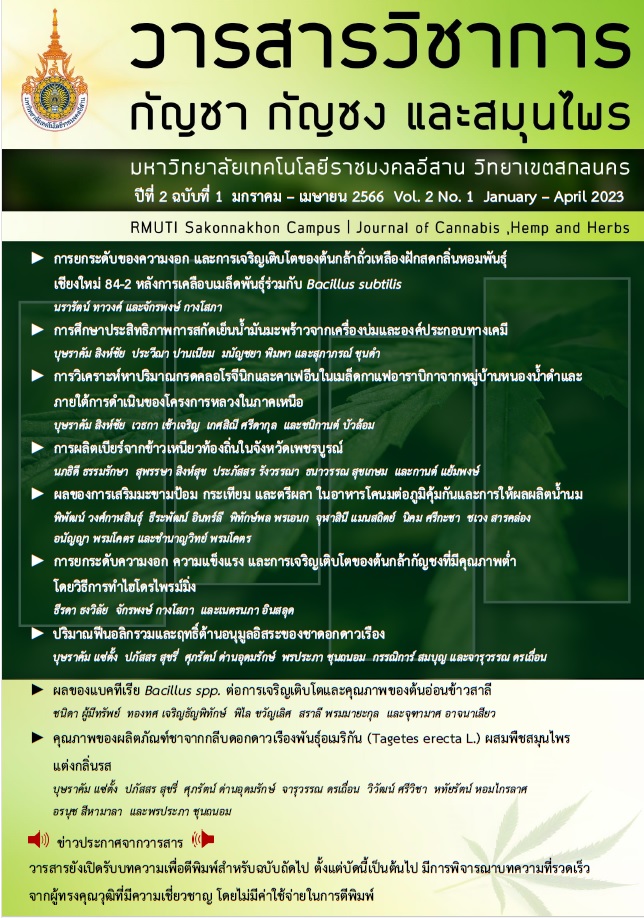ผลของแบคทีเรีย Bacillus spp. ต่อการเจริญเติบโตและคุณภาพของต้นอ่อนข้าวสาลี
คำสำคัญ:
น้ำคั้นต้นอ่อนข้าวสาลี คุณค่าทางโภชนาการ คลอโรฟิลล์ แบคทีเรียส่งเสริมการเจริญเติบโตของพืชบทคัดย่อ
น้ำคั้นต้นอ่อนข้าวสาลีมีสารอาหารที่มีคุณค่าทางโภชนาการสูงหลากหลาย โดยเฉพาะคลอโรฟิลล์ ซึ่งมีผลในการบำบัดภาวะขาดฮีโมโกลบินได้ ทั้งนี้มีรายงานว่าแบคทีเรียส่งเสริมการเจริญเติบโตของพืช (PGPB) สามารถเพิ่มการผลิตสารออกฤทธิ์และกระตุ้นการเจริญเติบโตของพืชได้ การใช้ PGPB จึงเป็นแนวทางหนึ่งในการเพิ่มคุณค่าทางโภชนาการให้กับน้ำคั้นต้นอ่อนข้าวสาลีได้ ดังนั้นเพื่อทดสอบความสามารถดังกล่าวของ PGPB จึงทำการคัดเลือกแบคทีเรียสกุล Bacillus จำนวน 8 ไอโซเลตมาทำการทดสอบ โดยแบ่งการทดสอบเป็น 3 ส่วน ได้แก่ 1) การประเมินคุณสมบัติของแบคทีเรียในการสร้าง indole-3-acetic acid (IAA) ละลายฟอสเฟต และตรึงไนโตรเจน 2) การทดสอบอิทธิพลของแบคทีเรียต่อความงอกและความแข็งแรงของเมล็ดข้าวสาลี และ 3) การทดสอบผลของแบคทีเรียในการส่งเสริมการเจริญเติบโตและคุณภาพของต้นอ่อนข้าวสาลี ด้วยการให้แบคทีเรียโดยวิธีการแช่เมล็ดและวิธีการรดต้นอ่อนข้าวสาลี การทดสอบพบว่า การแช่เมล็ดในแขวนลอยแบคทีเรียไม่มีผลต่อความงอกและความแข็งแรงของเมล็ดข้าวสาลี และการแช่เมล็ดในแขวนลอยแบคทีเรียก่อนปลูกไม่มีผลในการกระตุ้นการเจริญเติบโตและคุณภาพผลผลิตต้นอ่อนข้าวสาลี อย่างไรก็ตามการรดต้นกล้าด้วยแขวนลอยแบคทีเรีย มีผลทำให้ต้นอ่อนข้าวสาลีมีความยาวต้นและน้ำหนักสดเพิ่มขึ้น แต่ไม่มีผลในการเพิ่มคุณภาพของผลผลิตต้นอ่อนข้าวสาลี ทั้งนี้ผลการทดสอบแสดงให้เห็นว่าศักยภาพในการส่งเสริมการเจริญเติบโตของต้นอ่อนข้าวสาลีอาจมีความสัมพันธ์กับระดับการสร้าง IAA และ Bacillus spp. บางไอโซเลต เช่น B07 มีศักยภาพในการส่งเสริมการเติบโตและคุณภาพของของต้นอ่อนข้าวสาลี อย่างไรก็ตามจำเป็นต้องทำการศึกษาเพิ่มเติมเพื่อค้นหาวิธีการที่เหมาะสมในการใช้ประโยชน์จากแบคทีเรียเหล่านี้ต่อไป
เอกสารอ้างอิง
สาธิต ปิ่นมณี , ศิลาวัน จันทรบุตร และกาญจนา พิบูลย์. (2555). การพัฒนาวัสดุเพาะการใช้ประโยชน์จากกากต้นอ่อนข้าวสาลี. ใน สัมมนาวิชาการกลุ่มศูนย์วิจัยข้าวภาคเหนือตอนบนและภาคเหนือตอนล่าง ประจำปี 2555. พิษณุโลก. กรมการข้าว สำนักวิจัยและพัฒนาข้าว.
Abdul-Baki A. A. and Anderson J. D. (1973). Vigour determination in soybean seed by multiplication. Crop Science. 3: 630-633
.
Ahmed A. and Hasnain S. (2010). Auxin-producing Bacillus sp.: Auxin quantification and effect on the growth of Solanum tuberosum. Pure and Applied Chemistry. 82(1): 313-319.
Arnon, D. I. (1949). Copper enzymes in isolated chloroplasts. Polyphenoloxidase in Beta vulgaris. Plant physiology. 24(1): 1.
Esitken A., Yildiz H. E., Ercisli S., Donmez M. F., Turan M. and Gunes A. (2010). Effects of plant growth promoting bacteria (PGPB) on yield, growth and nutrient contents of organically grown strawberry. Scientia Horticulturae. 124(1): 62-66.
Efthimiadou A., Katsenios N., Chanioti S., Giannoglou M., Djordjevic N. and Katsaros G. (2020). Effect of foliar and soil application of plant growth promoting bacteria on growth, physiology, yield and seed quality of maize under Mediterranean conditions. Scientific Reports. 10(1): 1-11.
Glick B. R. (2012). Plant growth-promoting bacteria: mechanisms and applications. Scientifica. 2012: 1-15.
Kaur, N., Singh, B., Kaur, A., Yadav, M. P., Singh, N., Ahlawat, A. K., and Singh, A. M. (2021). Effect of growing conditions on proximate, mineral, amino acid, phenolic composition and antioxidant properties of wheatgrass from different wheat (Triticum aestivum L.) varieties. Food Chemistry, 341: 128201
Lim J. H. and Kim S. D. (2013). Induction of drought stress resistance by multi-functional PGPR Bacillus licheniformis K11 in pepper. The Plant Pathology Journal. 29(2): 201.
Oves M., Khan M. S. and Qari H. A. (2017). Ensifer adhaerens for heavy metal bioaccumulation, biosorption, and phosphate solubilization under metal stress condition. Journal of the Taiwan Institute of Chemical Engineers. 80: 540-552.
Padalia S., Drabu S., Raheja I., Gupta A. and Dhamija M. (2010). Multitude potential of wheatgrass juice (green blood): an overview. Chron Young Sci. 1(2): 23–28.
Poly F., Monrozier L. J. and Bally R. (2001). Improvement in the RFLP procedure for studying the diversity of nifH genes in communities of nitrogen fixers in soil. Research in Microbiology. 152(1): 95-103.
Radhakrishnan R., Hashem A. and Abd_Allah E. F. (2017). Bacillus: A biological tool for crop improvement through bio-molecular changes in adverse environments. Frontiers in Physiology. 8: 667.
Rahman M., Sabir A. A., Mukta J. A., Khan M., Alam M., Mohi-Ud-Din M., Miah Md. G., Rahman M. and Islam M. T. (2018). Plant probiotic bacteria Bacillus and Paraburkholderia improve growth, yield and content of antioxidants in strawberry fruit. Scientific Reports. 8(1): 1-11.
Rajer F. U., Samma M. K., Ali Q., Rajar W. A., Wu H., Raza W., Xie Y., Tahir H. A. S. and Gao X. (2022). Bacillus spp.-mediated growth promotion of rice seedlings and suppression of bacterial blight disease under greenhouse conditions. Pathogens. 11(11): 1251.
Singh K., Verma C. and Kumar R. (2015). Comparative study of PGPR isolated from crop plants (mustard and maize) and wild medicinal plant (Lantana) and their potency for enhancement of wheat plant. International Journal of Pharmaceutical & Biological Archives. 6(1): 42-48.
Starovic M., Josic D., Pavlovic S., Drazic S., Postic D., Popovic T. and Stojanovic S. (2013). The effect of IAA producing Bacillus sp. Q3 strain on marshmallow seed germination. Bulgarian Journal of Agricultural Science. 19(3): 572-577.
Tabatabaei S., Ehsanzadeh P., Etesami H., Alikhani H. A. and Glick B. R. (2016). Indole-3-acetic acid (IAA) producing Pseudomonas isolates inhibit seed germination and α-amylase activity in durum wheat (Triticum turgidum L.). Spanish Journal of Agricultural Research. 14(1): 15.
Thammana M., Sreerangam S. and Nambaaru S. (2016). A mini review on wheatgrass. Journal of Pharmacognosy and Phytochemistry. 4(3): 13-19.
ดาวน์โหลด
เผยแพร่แล้ว
รูปแบบการอ้างอิง
ฉบับ
ประเภทบทความ
สัญญาอนุญาต
ลิขสิทธิ์ (c) 2023 วารสารวิชาการ กัญชา กัญชง และสมุนไพร

อนุญาตภายใต้เงื่อนไข Creative Commons Attribution-NonCommercial-NoDerivatives 4.0 International License.
ประกาศเกี่ยวกับลิขสิทธิ์
เนื้อหาและข้อมูลในบทความที่ลงตีพิมพ์ในวารสารทดสอบระบบ ThaiJo2 ถือเป็นข้อคิดเห็นและความรับผิดชอบของผู้เขียนบทความโดยตรงซึ่งกองบรรณาธิการวารสาร ไม่จำเป็นต้องเห็นด้วย หรือร่วมรับผิดชอบใด ๆ
บทความ ข้อมูล เนื่อหา รูปภาพ ฯลฯ ที่ได้รับการดีพิมพ์ในวารสารทดสอบระบบ ThaiJo2 ถือเป็นลิขสิทธิ์ของวารสารทดสอบระบบ ThaiJo2 หากบุคคลหรือหน่วยงานใดต้องการนำทั้งหมดหรือส่วนหนึ่งส่วนใดไปเผยแพร่หรือเพื่อกระทำการใดๆ จะต้องได้รับอนุญาตเป็นลายลักอักษรณ์จากวารสารทดสอบระบบ ThaiJo2 ก่อนเท่านั้น









